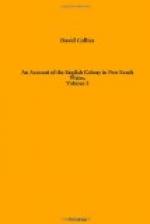October.] The Buffalo sailed for England on the 21st of October*, and as the governor had intended to touch and land at Norfolk Island, for the purpose of learning, from his own observation, something of the state of that settlement, some few of the Irish prisoners, who were suspected of laying plans of insurrection and massacre, were taken in the Buffalo, and landed there. This settlement wore a most unpromising appearance. All the buildings were in a state of rapid decay, and but few symptoms of industry were visible. Of stock, only a few hogs and a small quantity of vegetables were to be procured. On Phillip Island, which had formerly fed a great number of hogs, not one was to be found alive, they having, for want of better food, destroyed each other. A few fields of wheat, which were ready for reaping, looked tolerably well; but on the whole Norfolk Island by no means promised to repay the expense which it annually cost the government.
[* The Buffalo arrived at Spithead, with a convoy which she brought from St. Helena, on the 24th of May 1801, having made the passage by Cape Horn in seven months.]
On board of the Buffalo were two of the birds denominated by Dampier black-swans, and three of those which in New South Wales were styled emus. However much in shape the former resembled the European swan, yet, as they are of a different species, they are not properly entitled to the appellation of swan, that name being appropriate solely to the European species. These birds had with very great care been brought alive to England, and were given by Lieutenant William Kent, the proprietor, to Earl St. Vincent, who presented them as rarae aves and literally ‘nigro simillimae cygno’ to her Majesty, by whom they were sent to Frogmore. They were of different sexes; but unfortunately one of them soon died in moulting; and the other having, after that operation, with his health, also recovered the perfect use of his wings, availed himself of the liberty they gave him (the precaution of cutting them not having been taken), and was shot by a nobleman’s game-keeper as it was flying across the Thames.
The other birds were given by the same gentleman to Sir Joseph Banks; and they are now enjoying their freedom in the Earl of Exeter’s park at Burleigh. These birds have been pronounced by Sir Joseph Banks, of whose judgment none can entertain a doubt, to come nearer to what is known of the American ostrich, than to either the emu of India, or the ostrich of Africa. (The subjoined engraving is from a drawing made in New South Wales, and shows the height to which they can erect themselves.)
CONCLUSION
The documents upon which the foregoing pages have been formed going no farther than the departure of the Buffalo for England, we must here quit the regular detail of the transactions of the colony.




